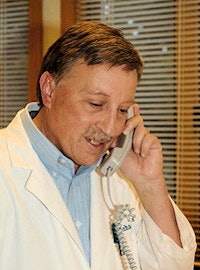
Some experts examining the Affordable Care Act (ACA) have estimated a 25% to 33% increase in eligibility. What they may miss is that enrollment eligibility for potential patients does not necessarily equate into actual patients having access to dental care. Eligibility for services is a different element than access to those services. While this makes perfect logic to small or large healthcare business owners or managers, it may be outside the comprehension abilities of Washington bureaucrats.
In 2007, the U.S. Health and Human Services Office of Inspector General (HHS-OIG) issued a troubling report, which stated 31% of reviewed dental Medicaid submissions were improper. Again, please take note of that number -- 31%!
That degree of dental Medicaid fraud, waste, and abuse is not sustainable. The taxpayer cannot and should not fund such a dysfunctional program, no matter how well intentioned. Throwing limited public money at problems of disadvantaged children with dental needs, without adequate oversight, regulation, and enforcement represents an abuse to the American taxpayer. That unfortunate reality is slowly changing.
 Michael W. Davis, DDS.
Michael W. Davis, DDS.
Specifically within the ACA are additional regulatory dental Medicaid oversight mechanisms, as well as mandatory compliance rules, in which diagnostic records must duly and fully support all patient treatments. For most clinical practitioners, this isn't something new or strange. As early as dental school, clinicians are trained to obtain diagnostic-quality radiographs, intraoral photographs, and clinical notes of the physical exam to support their treatments. The ACA also requires obtaining such records to support follow-up clinical treatments under any PPO or DHMO plan a dentist may be participating with. This represents minimal standard of care.
Unfortunately for disadvantaged patients, numbers of dental Medicaid providers have historically ignored minimal standards of care. (Please reference the July 2013 "Joint Staff Report on the Corporate Practice of Dentistry in the Medicaid Program," from the bipartisan committees, the Finance Committee and the Judiciary Committee, of the U.S. Senate, which is available here.) It is rare to see congressional Democrats and Republicans agree on much of anything these days. However, they came together on this alarming report.
The U.S. Senate study gave troubling evidence of interstate corporate dental groups, often directed by the private equity banking industry and not doctors, abusively treating disadvantaged children in order to maximize dollar production per patient (PPP). The Senate report honestly disavowed the common misrepresentation of dental service organizations as only focused on nonclinical elements of dental practice. Doctors were managed with quotas and bonuses. Patient interests took a backseat to company interests to generate profits from Medicaid.
Further highlighted in the recent Senate report was a condemnation of regulatory efforts of the HHS-OIG. Dental Medicaid violators were given repeated wrist slaps for habitual cheating of taxpayers and harming the disadvantaged. Regulators, both at the state and federal levels, disregarded true enforcement of federal and state statutes and Medicaid rules. In essence, the farmer gave control of the henhouse to the foxes.
In New York State Supreme Court last year, a public record trial was conducted (Jeremy Bohn v. Forba Holdings, et al, index No. 2011-2128, RJI No. 33-11-1413). That trial is commonly called the New York Small Smiles dental trial. From the public record trial transcripts, a number of highly disturbing facts came into the public domain. The trial judge, Judge Deborah Karalunas ruled as material fact that Small Smiles Dental was operating unlawfully in New York state, because corporate managers, and not licensed doctors onsite, were directing patient care. Witnesses for the defense contended that no parental informed consents were required for use of patient restraints, despite contradiction from the guidelines of the American Academy of Pediatric Dentistry (AAPD). These defense witnesses were themselves former officers of the AAPD. These doctors stated there were no associated risks from child restraints, so no parental informed consents were required. (Believe me, connections between Small Smiles Dental and a number of former officers of the AAPD are worth a full report, in and of itself.)
The corporate dental term of maximizing PPP finally saw the light of day. The rampant use of child restraints was one of several mechanisms to maximize PPP, regardless of a child's stamina and comprehension. Certainly, the parent had no idea and had no access to the clinical treatment area. I invite any interested doctor to read and review these alarming trial transcripts.
These Medicaid child abuses and ripping off of taxpayers actually came into the public domain and to the attention of lawmakers long before the New York Small Smiles dental trial. Bloomberg Business News, PBS' "Frontline," ABC News, NBC News, "Inside Edition," WFAA-TV in Dallas, and Byron Harris and Roberta Baskin while with ABC Washington, etc. all reported on the cheating of taxpayers through various dental Medicaid scams, and exactly how disadvantaged kids were mistreated. The Medicaid-related cesspool within the dental profession has been festering into a humongous stink, for quite a long time.
Things are changing. Not a week goes by when seemingly yet another doctor isn't indicted or convicted for Medicaid fraud. Unfortunately, it's usually only associate dentists, and not the corporate managers, who get thrown under the bus. This involves not only restitution, fines, and penalties, as well as community service, but also often actual prison time.
State dental practice acts and standard of care are changing. For example, Colorado requires dentists to obtain written parental or guardian informed consent prior to child restraint. Parental access to their child's dental treatment also is mandated by statute, unless clear and valid reasons for not doing so are recorded in patient's chart. The old days of keeping parents removed from their child's dental treatment and not informing parents of options for possible care delivered, inclusive of risks, benefits, and no treatment, are ending. The rampant and abusive use of child restraints to maximize Medicaid production also is ending (although there are very valid uses for restraints with appropriate informed consent, especially for highly impaired institutionalized patients or those requiring a profound level of sedation).
Ending the abuse associated with child restraints has cut deeply into the profits of these dental Medicaid mills. They are less able to "roundhouse" a disadvantaged child with steel crowns and pulpotomies. Plus, if they today elect to buzz down multiple teeth for steel crowns, the provider better have quality pretreatment radiographs to justify such invasive care. The modern Medicaid investigator is increasingly less an enabler of abuse and dysfunction, but a policeman, as they should be. That's a big change sparked by the ACA.
Tomorrow, in part 2, Dr. Davis continues with an examination of certain practices, then itemizes things to watch for when considering becoming involved in a practice that includes the Medicaid market.
Michael W. Davis, DDS, maintains a private general dental practice in Santa Fe, NM. He serves as chairperson for the Santa Fe District Dental Society Peer Review. He is also active in expert witness legal services.
The comments and observations expressed herein do not necessarily reflect the opinions of DrBicuspid.com, nor should they be construed as an endorsement or admonishment of any particular idea, vendor, or organization.



















